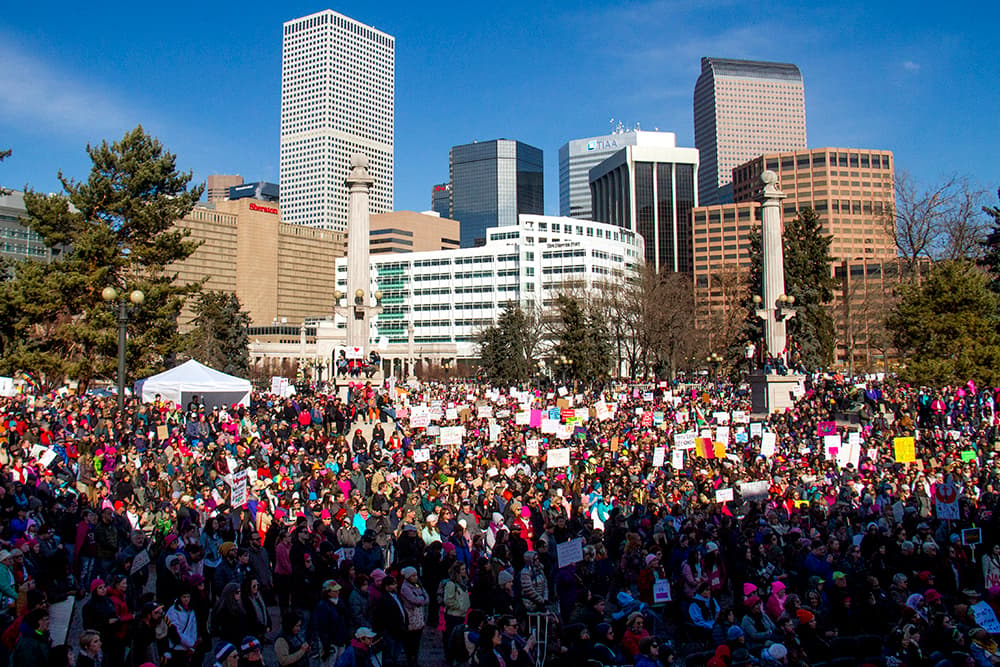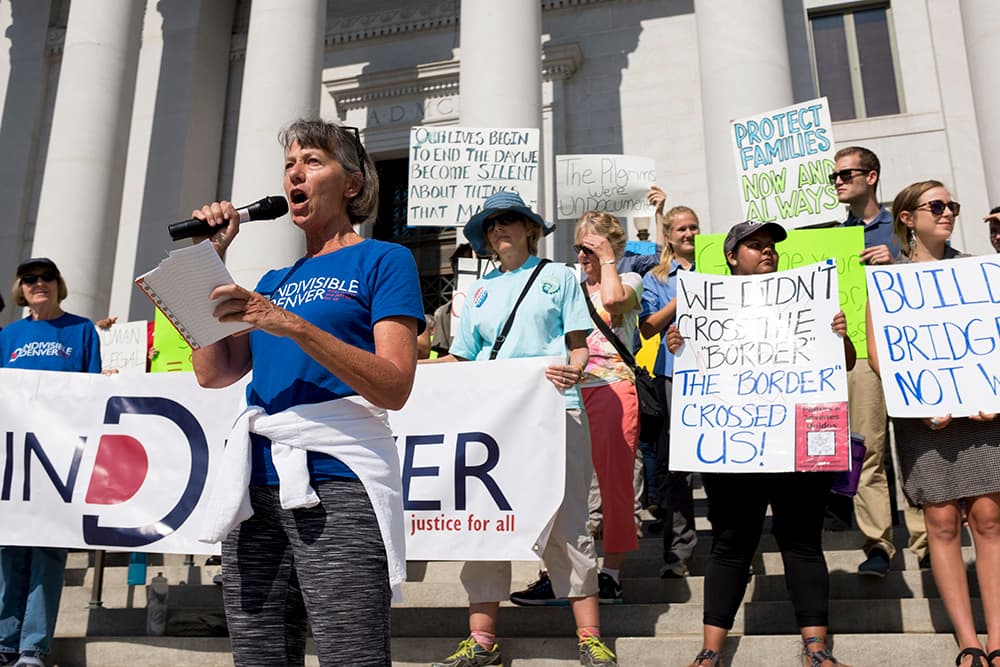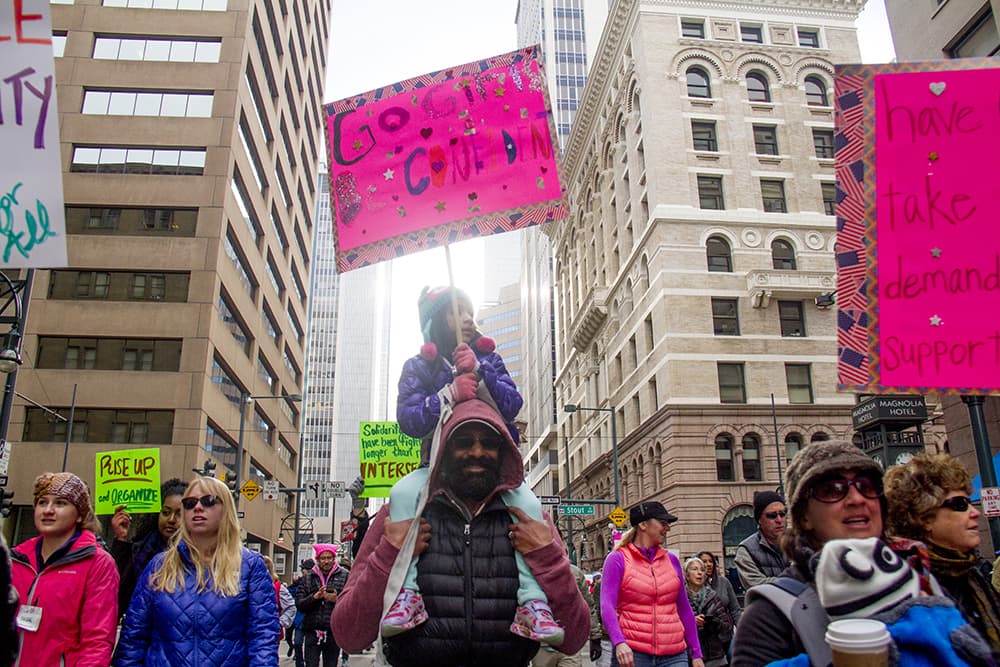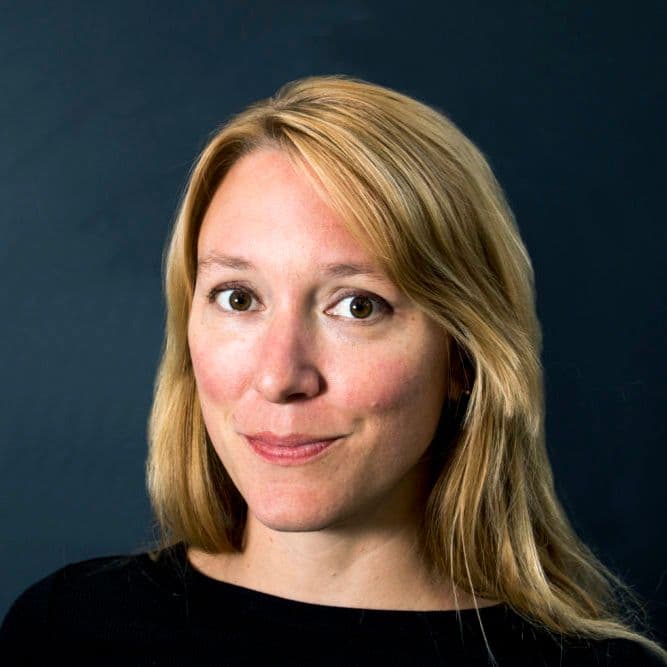
On the 21st day of 2017 — 74 days after the 2016 presidential election and one day after President Donald Trump's inauguration — hundreds of thousands of people in cities across the country took to the streets for a Women’s March. More than 100,000 of those marchers were in Denver.
It kicked off seven consecutive Saturdays of protests in Denver and set the tone for a year that saw, unfailingly, demonstrations at just about every political and social flashpoint in 2017.
On Jan. 20, 2018, the Women’s March returns for a second round. It’s difficult to predict whether the crowd will reach last year’s enormous size, but the feeling among organizers and activists is that the energy is still there — but it has different jobs to do this year.
“I think we have an understanding now of what the administration really looks like and how we react to that as a group and how quickly we can mobilize,” said Jessica Rogers, one of four organizers of the Women’s March on Colorado. “I don’t think things have changed in needing to be less vigilant — if anything we need to be more vigilant. And if anything, it’s taught us the shape of how that looks. I really think that at last year’s march everybody just felt so lost. So lost.”
“Lost” is not the word anyone would use to describe activists or even the average civically engaged Denverite in 2018. Over the past year, new groups have organized and old ones have shored up numbers, alliances and connections have formed, conversations and messaging have become more nuanced, and reactions have come more swiftly.
Dana Miller, a community activist in Denver and member of one of the 6,000 Indivisible groups that sprang up around the country after Trump’s election, said activism in Denver has become better informed and better connected since the Women’s March.
“But there was also something that kind of happened in Indivisible Denver which, as in most organizations — nationwide, Indivisible had the tendency to be white, middle-aged women of middle income — and so that kind of started [us asking], ‘How are we going to be more inclusive? Get people of color? Get more men?’ We didn't know how to do it, so we came up with this strategy, if you can call it that. ‘Showing up for other people’s stuff’ is what we call it.
“Our vision for that was just showing up, listening and learning and ask how we can help.”
In practice, she said, that has meant showing up at meetings where people were discussing LGBTQ issues or sitting in on meetings with disability rights groups.
Activism has also become far more adaptable and flexible.
“Things change every single flippin' day,” Miller said. “All this stuff is happening really quickly, so we’ve become really nimble.”
Whatever the issue of the moment is, she said, they’ve learned to respond quickly and creatively.

But the point of the Women’s March wasn’t to spark a year of protests, it was to show that women were fed up — that we’re tired of sexual harassment and unequal pay, and the persistent disregard for those and other issues of inequity. It was to say loudly and clearly, “You can’t ignore us anymore. You have to listen to women.”
It’s fair to say that was a theme throughout 2017. The year culminated in the explosion of the #MeToo movement, which had been started by civil rights activist Tarana Burke a decade ago.
“I think the Women’s March was a catalyst in a lot of ways,” Rogers said. “It woke up a lot of white women. I think women of color have been seeing these issues in their communities a lot longer. I think the response from women is something we wouldn’t have ever seen had Hillary been elected. The unmasking of all the sexual assault would not have happened.
“I think that women in general are just like, ‘You know what? No. We’re done. You’re done.’”
And while #MeToo — or what others called “the Year of Male Consequences” — took the figurative and literal spotlight last year, other changes were underway.
Lauren Y. Casteel, president and CEO of the Women’s Foundation of Colorado, said the word "empowerment" doesn’t suit what’s happened in the past year because women have always had power. Instead, she said, we’ve been “uncovering the inherent power of women.”
Casteel counts a heightened awareness of sexual harassment as well as gender inequity and financial abuse in workplace among last year’s victories, thanks in part to “champions in more visible arenas, celebrated in our communities,” but she’s seen progress in less flashy ways, too.
“Businesses are starting fully to make some inroads to equal pay,” she said.
Citigroup, for example, became one of the first U.S. banks to respond to shareholder concerns about inequality in the workplace when it announced earlier this week that it would increase pay for women and minorities in an effort to close the pay gap.
In Colorado, Denver-based DaVita spent the year operating with its freshly appointed “majority diverse” board of directors — 50 percent women and minorities.
Change is permeating city, state and national governments, too. In April, Denver released the results of an independent analysis of pay equity for city employees that said women were given equal pay for equal work.
And when it comes to running for office, Casteel said, we’re going to see the momentum that’s been building all year reach a head in the 2018 elections.
“Women have run for office in record numbers, and I’m hearing more and more conversation — just yesterday I was at the Denver Art Museum and someone was talking about how they heard of new women who were going to be running for elected office,” she said. “Similarly, in November, you probably saw the number of really diverse women nationally who were elected to office as mayors and to general assembly, women of different sexual orientations and ethnic groups.
“Research shows that women can make government more transparent, inclusive and accessible."

Still, there’s plenty more work to be done. Part of that is recognizing now that “women are not a monolith,” Casteel said. We not only need to continue to address the pay gap, but we need to address it in a way that recognizes pay disparity among women based on geography and race or ethnicity. The same same applies as we continue to tackle sexual harassment, particularly in the workplace.
Generally speaking, the fact that there’s more work to be done is why the Denver organizers of the Women’s March decided in October to do it again this year.
“There was of course the issue of, ‘What was the first one? What did it do? What was is for? If we’re going to do it again, are we going to repeat the same messages?’” Rogers said. “At the end, we realized how much we as organizers and other people valued it as a catalyst for action, especially as we go into the 2018 elections. We also agreed it was important to have a galvanizing movement.”
There is some concern that maybe people are losing steam. Regular organizing and rallying over the course of a year can be tiring. Even over the course of those first seven Saturdays of protests in 2017, fewer and fewer people were showing up. But, generally speaking, there’s a feeling that it’s not so much about the number of people as the intensity in the people.
“I am not at all discouraged. I think what we’ve learned … is that actually getting out there and doing the hard work makes a difference,” Miller said. “Our Indivisible Denver meetings were 300 people for the first couple months. Now they’re 50 to 100, but the level of engagement… it’s kind of more organized. The relationships that people have made with each other over the year are probably the most powerful.”
Programmatically speaking, this year’s event is structured similarly to last year's. The main logistical difference is that the initial gathering will be at Civic Center Park’s amphitheater, where they’re set up for sound and can begin the march with a speech.
The theme this year is “Hear My Truth,” and the speakers, Rogers said, are average women. They include, just to name a few, Ismahan Afrah, a 19-year-old Metro State student and child of Somali immigrants; Robin Otey, the Colorado charter member of the Black Girl Justice League; Nga Vuong-Sandoval, a Mayor-appointed city commissioner for the Denver Asian-American Pacific Islander Commission; and Mary Ryan, a full-blood Sicangu, Lakota from the Rosebud Reservation in South Dakota.
“The tone is going to be a little bittersweet, maybe. It is going to be hearing the stories of women who have lived a lot of the grievances we’ve seen this administration handing out,” Rogers said, “but the sweet part of it is we’re all here hearing these stories and thinking, ‘No. No. This not OK.’”
But ultimately, she said, it comes down to this: “Being in that crowd always makes me feel like we can do anything.”

What you need to know if you go:
The Women's March on Colorado will be held on Saturday, Jan. 20. People are asked to start congregating in Civic Center Park at 8:30 a.m. A pre-rally program will start at 9 a.m. and the march will begin at 9:30 a.m. The rally portion, featuring about a dozen speakers, will start at 11:30 a.m.
Here's the route map provided by organizers:
You can find tips on safety and what to bring with you at marchoncolorado.org.
After the march:
There are nine meet-ups planned for the Sunday after the march.
"Those events are specifically to get people who are interested in doing something or even just hearing about the things that are possible to do," Rogers said.
They'll discuss things like what commissioner offices are open, how to be a precinct captain, how to testify for legislative issues, how to campaign for a candidate and how to do call in campaigns.
The meet-ups are being held in Denver, Aurora, Arvada, Boulder, Fort Collins, Golden, Grand Junction, Lafayette and Longmont. You can learn more at marchoncolorado.org.
Correction: The number of Women's March on Colorado organizers initially given in this story was incorrect. It has been updated with the correct number, which is four.











